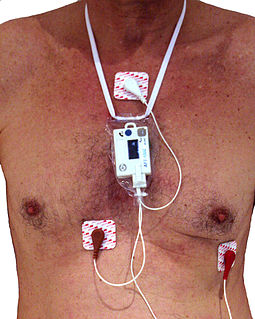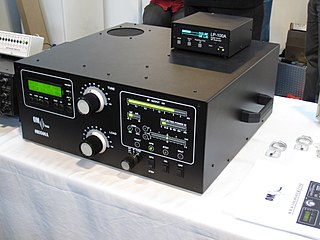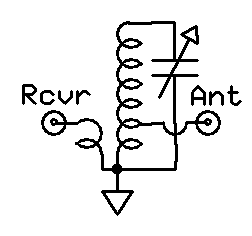Related Research Articles
In electronics, the figures of merit of an amplifier are numerical measures that characterize its properties and performance. Figures of merit can be given as a list of specifications that include properties such as gain, bandwidth, noise and linearity, among others listed in this article. Figures of merit are important for determining the suitability of a particular amplifier for an intended use.

An amplifier, electronic amplifier or (informally) amp is an electronic device that can increase the magnitude of a signal. It may increase the power significantly, or its main effect may be to boost the voltage or current. It is a two-port electronic circuit that uses electric power from a power supply to increase the amplitude of a signal applied to its input terminals, producing a greater amplitude signal at its output. The ratio of output to input voltage, current, or power is termed gain. An amplifier, by definition has gain greater than unity.

Electrocardiography is the process of producing an electrocardiogram, a recording of the heart's electrical activity. It is an electrogram of the heart which is a graph of voltage versus time of the electrical activity of the heart using electrodes placed on the skin. These electrodes detect the small electrical changes that are a consequence of cardiac muscle depolarization followed by repolarization during each cardiac cycle (heartbeat). Changes in the normal ECG pattern occur in numerous cardiac abnormalities, including cardiac rhythm disturbances, inadequate coronary artery blood flow, and electrolyte disturbances.
A low-noise amplifier (LNA) is an electronic amplifier that amplifies a very low-power signal without significantly degrading its signal-to-noise ratio. An amplifier will increase the power of both the signal and the noise present at its input, but the amplifier will also introduce some additional noise. LNAs are designed to minimize that additional noise. Designers can minimize additional noise by choosing low-noise components, operating points, and circuit topologies. Minimizing additional noise must balance with other design goals such as power gain and impedance matching.

Biofeedback is the process of gaining greater awareness of many physiological functions of one's own body by using electronic or other instruments, and with a goal of being able to manipulate the body's systems at will. Humans conduct biofeedback naturally all the time, at varied levels of consciousness and intentionality. Biofeedback and the biofeedback loop can also be thought of as self-regulation. Some of the processes that can be controlled include brainwaves, muscle tone, skin conductance, heart rate and pain perception.

A preamplifier, also known as a preamp, is an electronic amplifier that converts a weak electrical signal into an output signal strong enough to be noise-tolerant and strong enough for further processing, or for sending to a power amplifier and a loudspeaker. Without this, the final signal would be noisy or distorted. They are typically used to amplify signals from analog sensors such as microphones and pickups. Because of this, the preamplifier is often placed close to the sensor to reduce the effects of noise and interference.

Willem Einthoven was a Dutch doctor and physiologist. He invented the first practical electrocardiograph in 1895 and received the Nobel Prize in Physiology or Medicine in 1924 for it.

An active filter is a type of analog circuit implementing an electronic filter using active components, typically an amplifier. Amplifiers included in a filter design can be used to improve the cost, performance and predictability of a filter.

In medicine, a Holter monitor is a type of ambulatory electrocardiography device, a portable device for cardiac monitoring for at least 24 hours.

Electromyography (EMG) is a technique for evaluating and recording the electrical activity produced by skeletal muscles. EMG is performed using an instrument called an electromyograph to produce a record called an electromyogram. An electromyograph detects the electric potential generated by muscle cells when these cells are electrically or neurologically activated. The signals can be analyzed to detect abnormalities, activation level, or recruitment order, or to analyze the biomechanics of human or animal movement. Needle EMG is an electrodiagnostic medicine technique commonly used by neurologists. Surface EMG is a non-medical procedure used to assess muscle activation by several professionals, including physiotherapists, kinesiologists and biomedical engineers. In Computer Science, EMG is also used as middleware in gesture recognition towards allowing the input of physical action to a computer as a form of human-computer interaction.
In neuroscience, single-unit recordings provide a method of measuring the electro-physiological responses of a single neuron using a microelectrode system. When a neuron generates an action potential, the signal propagates down the neuron as a current which flows in and out of the cell through excitable membrane regions in the soma and axon. A microelectrode is inserted into the brain, where it can record the rate of change in voltage with respect to time. These microelectrodes must be fine-tipped, high-impedance conductors; they are primarily glass micro-pipettes, metal microelectrodes made of platinum, tungsten, iridium or even iridium oxide. Microelectrodes can be carefully placed close to the cell membrane, allowing the ability to record extracellularly.

Einthoven's triangle is an imaginary formation of three limb leads in a triangle used in electrocardiography, formed by the two shoulders and the pubis. The shape forms an inverted equilateral triangle with the heart at the center. It is named after Willem Einthoven, who theorized its existence.

A string galvanometer is a sensitive fast-responding measuring instrument that uses a single fine filament of wire suspended in a strong magnetic field to measure small currents. In use, a strong light source is used to illuminate the fine filament, and the optical system magnifies the movement of the filament allowing it to be observed or recorded by photography. The principle of the string galvanometer remained in use for electrocardiograms until the advent of electronic vacuum-tube amplifiers in the 1920s.

A biosignal is any signal in living beings that can be continually measured and monitored. The term biosignal is often used to refer to bioelectrical signals, but it may refer to both electrical and non-electrical signals. The usual understanding is to refer only to time-varying signals, although spatial parameter variations are sometimes subsumed as well.

A valve RF amplifier or tube amplifier (U.S.) is a device for electrically amplifying the power of an electrical radio frequency signal.

A preselector is a name for an electronic device that connects between a radio antenna and a radio receiver. The preselector is a band-pass filter that blocks troublesome out-of-tune frequencies from passing through from the antenna into the radio receiver that otherwise would be directly connected to the antenna.
Targeted reinnervation enables amputees to control motorized prosthetic devices and to regain sensory feedback. The method was developed by Dr. Todd Kuiken at Northwestern University and Rehabilitation Institute of Chicago and Dr. Gregory Dumanian at Northwestern University Division of Plastic Surgery.

Electroencephalography (EEG) is a method to record an electrogram of the spontaneous electrical activity of the brain. The biosignals detected by EEG have been shown to represent the postsynaptic potentials of pyramidal neurons in the neocortex and allocortex. It is typically non-invasive, with the EEG electrodes placed along the scalp using the International 10-20 system, or variations of it. Electrocorticography, involving surgical placement of electrodes, is sometimes called "intracranial EEG". Clinical interpretation of EEG recordings is most often performed by visual inspection of the tracing or quantitative EEG analysis.

The neurotrophic electrode is an intracortical device designed to read the electrical signals that the brain uses to process information. It consists of a small, hollow glass cone attached to several electrically conductive gold wires. The term neurotrophic means "relating to the nutrition and maintenance of nerve tissue" and the device gets its name from the fact that it is coated with Matrigel and nerve growth factor to encourage the expansion of neurites through its tip. It was invented by neurologist Dr. Philip Kennedy and was successfully implanted for the first time in a human patient in 1996 by neurosurgeon Roy Bakay.
An electrogram (EGM) is a recording of electrical activity of organs such as the brain and heart, measured by monitoring changes in electric potential.
References
- 1 2 3 4 5 6 7 8 9 Webster, John G. (2006) Encyclopedia of Medical Devices and Instrumentation Volume I. New Jersey: Wiley-Interscience. ISBN 978-0-471-26358-6.
- ↑ Rivera-Ruiz, M; Cajavilca, C; Varon, J (1927). "Einthoven's String Galvanometer: The First Electrocardiograph". Texas Heart Institute Journal. 35 (2): 174–8. PMC 2435435 . PMID 18612490.
- ↑ Rowbottom ME, Susskind C. In: Electricity and Medicine: History of their Interaction. San Francisco (CA): San Francisco Press; 1984.
- ↑ Ernstine and Levine report the use of vacuum-tubes to amplify the electrocardiogram instead of the mechanical amplification of the string galvanometer. Ernstine, AC; Levine, SA (1928). "A comparison of records taken with the Einthoven string galvanometer and the amplifier-type electrocardiograph". American Heart Journal. 4 (6): 725–731. doi:10.1016/S0002-8703(29)90554-8.
- ↑ "ECG- simplified. Aswini Kumar M.D.". LifeHugger.
- 1 2 3 Brumberg, J. S.; Nieto-Castanon, A.; Kennedy, P. R.; Guenther, F. H. (2010). "Brain–computer interfaces for speech communication". Speech Communication. 52 (4): 367–379. doi:10.1016/j.specom.2010.01.001. PMC 2829990 . PMID 20204164.
- ↑ Northrop, R. B. (2012). Analysis and Application of Analog Electronic Circuits to Biomedical Instrumentation. CRC Press.
- ↑ Martini, Frederic; Bartholomew, Edwin (2003). Essentials of Anatomy & Physiology. San Francisco: Benjamin Cummings. p. 267. ISBN 0-13-061567-6.
- ↑ Carlson, Neil (2013). Physiology of Behavior. New Jersey: Pearson Education, Inc. ISBN 978-0-205-23939-9.
- ↑ Interview with Dr. Kennedy, Senior Research Scientist, Neural Signals, Inc., 9/30/2010
- ↑ Kennedy, P. R.; Kirby, M. T.; Moore, M. M.; King, B.; Mallory, A. (2004). "Computer control using human intracortical local field potentials". IEEE Transactions on Neural Systems and Rehabilitation Engineering. 12 (3): 339–344. doi:10.1109/TNSRE.2004.834629. PMID 15473196. S2CID 8760734.
- ↑ Bronzino, Joseph D. (2006). The Biomedical Engineering Handbook, Third Edition. Florida: CRC Press.
- 1 2 3 4 Interview with Dr. Potter, Associate Professor, Georgia Institute of Technology, 10/16/2013
- ↑ "Tellurex - Peltier FAQ". Tellurex. Retrieved 27 November 2013